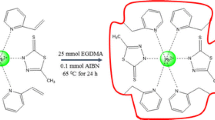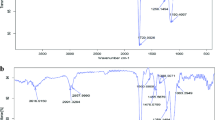Abstract
A solid phase extraction method using Pd2+ ion-imprinted polymer (Pd2+-IIP) nanoparticles combined with flame atomic absorption spectrophotometry (FAAS) was developed for the preconcentration and trace detection of palladium ions. The Pd2+-IIP nanoparticles were obtained by precipitation polymerization of 4-vinylpyridine (the functional monomer), ethylene glycol dimethacrylate (the cross-linker), 2,2′-azobisisobutyronitrile (the initiator), Eriochrome Cyanine R (the lead-binding ligand), and palladium ions (the template ion) in acetonitrile solution. The parameters affecting adsorption and desorption steps were optimized by a Box–Behnken design through response surface methodology. Three variables (pH value, extraction time, and amount of the synthesized IIP) were selected as the main factors affecting sorption step, while four variables (type of eluent, volume of the eluent, concentration of the eluent, and elution time) were selected for desorption step in the optimization study. The optimized values by this optimization method were 30 mg, 15 min, 6.0, HCl, 4.0 mL, 1.8 mol L-l HCl, and 14 min, for amount of polymer, retention time, pH of solution, type, volume, concentration of the eluent, and elution time, respectively. Under the optimized conditions, the detection limit for the proposed method was found to be 0.2 μg L−1, while the relative standard deviation (RSD) for five replicate measurements was calculated to be <3 %. Finally, the introduced solid phase extraction technique was successfully applied for extraction and determination of Pd2+ ions in food and environmental samples.







Similar content being viewed by others
References
Bagheri A, Behbahani M, Amini MM, Sadeghi O, Tootoonchi A, Dahaghin Z (2012a) Preconcentration and separation of ultra-trace palladium ion using pyridine-functionalized magnetic nanoparticles. Microchim Acta 178:261
Bagheri A, Taghizadeh M, Behbahani M, Asgharinezhad AA, Salarian M, Dehghani A, Ebrahimzadeh H, Amini MM (2012b) Synthesis and characterization of magnetic metal-organic framework (MOF) as a novel sorbent, and its optimization by experimental design methodology for determination of palladium in environmental samples. Talanta 99:132
Banham J (2008) Annual report & accounts, Johnson Matthey. pp.19–20. Available at: <http://www.matthey.com/AR08/JM AR08.pdf >
Behbahani M, Taghizadeh M, Bagheri A, Hosseini H, Salarian M, Tootoonchi A (2012) A nanostructured ion-imprinted polymer for the selective extraction and preconcentration of ultra-trace quantities of nickel ions. Microchim Acta 178:429
Behbahani M, Babapour M, Amini MM, Sadeghi O, Bagheri A, Salarian M, Rafiee B (2013a) Separation/enrichment of copper and silver using titanium dioxide nanoparticles coated with poly-thiophene and their analysis by flame atomic absorption spectrophotometry. Am J Anal Chem 4:90
Behbahani M, Najafi M, Amini MM, Sadeghi O, Bagheri A, Salarian M (2013b) Dithizone-modified nanoporous fructose as a novel sorbent for solid-phase extraction of ultra-trace levels of heavy metals. Microchim Acta 180:911
Behbahani M, Najafi F, Amini MM, Sadeghi O, Bagheri A, Ghareh Hassanlou P (2014a) Solid phase extraction using nanoporous MCM-41 modified with 3, 4-dihydroxybenzaldehyde for simultaneous preconcentration and removal of gold (III), palladium (II), copper (II) and silver (I). J Ind Eng Chem 20:2248
Behbahani M, Gorji T, Mahyari M, Salarian M, Bagheri A, Shaabani A (2014b) Application of polypropylene amine dendrimers (POPAM)-grafted MWCNTs hybrid materials as a new sorbent for solid-phase extraction and trace determination of gold (III) and palladium (II) in food and environmental samples. Food Anal Methods 7:957
Behbahani M, Ali Akbari A, Amini MM, Bagheri A (2014c) Synthesis and characterization of pyridine-functionalized magnetic mesoporous silica and its application for preconcentration and trace detection of lead and copper ions in fuel products. Anal Methods 6:8785
Behbahani M, Esrafili A, Bagheri S, Radfar S, Kalate Bojdi M, Bagheri A (2014d) Modified nanoporous carbon as a novel sorbent before solvent-based de-emulsification dispersive liquid–liquid microextraction for ultra-trace detection of cadmium by flame atomic absorption spectrophotometry. Measurement 51:174
Behbahani M, Bagheri S, Amini MM, Sadeghi Abandansari H, Moazami HR, Bagheri A (2014e) Application of a magnetic molecularly imprinted polymer for the selective extraction and trace detection of lamotrigine in urine and plasma samples. J Sep Sci 37:1610
Behbahani M, Salarian M, Bagheri A, Tabani H, Omidi F, Fakhari A (2014f) Synthesis, characterization and analytical application of Zn (II)-imprinted polymer as an efficient solid-phase extraction technique for trace determination of zinc ions in food samples. J Food Compos Anal 34:81
Behbahani M, Abolhasani J, Amini MM, Sadeghi O, Omidi F, Bagheri A, Salarian M (2015) Application of mercapto ordered carbohydrate-derived porous carbons for trace detection of cadmium and copper ions in agricultural products. Food Chem 173:1207
Boch K, Schuster M, Risse G, Schwarzer M (2002) Microwave-assisted digestion procedure for the determination of palladium in road dust. Anal Chim Acta 459:257
Brereton RG (1990) Chemometrics. Ellis Horwood, Chichester
Chakrapani G, Mahanta PL, Murty DSR, Gomathy B (2001) Preconcentration of traces of gold, silver and palladium on activated carbon and its determination in geological samples by flame AAS after wet ashing. Talanta 53:1139
Daniel S, Babu PEJ, Prasada Rao T (2005) Preconcentrative separation of palladium (II) using palladium (II) ion-imprinted polymer particles formed with different quinoline derivatives and evaluation of binding parameters based on adsorption isotherm models. Talanta 65:441
Ebrahimzadeh H, Behbahani M (2013) A novel lead imprinted polymer as the selective solid phase for extraction and trace detection of lead ions by flame atomic absorption spectrophotometry: synthesis, characterization and analytical application. Arab J Chem. doi:10.1016/j.arabjc.2013.09.017
Elci L, Soylak M, Buyuksekerci EB (2003) Separation of gold, palladium and platinum from metallurgical samples using an amberlite XAD-7 resin column prior to their atomic absorption spectrometric determinations. Anal Sci 19:1621
Ely JC, Neal CR, Kulpa CF, Schneegurt MA, Seidler JA, Jain JC (2001) Implications of platinum-group element accumulation along U.S. roads from catalytic converter attrition. Environ Sci Technol 35:3816
Fouladian HR, Behbahani M (2014) Solid phase extraction of Pb (II) and Cd (II) in food, soil, and water samples based on 1-(2-pyridylazo)-2-naphthol-functionalized organic–inorganic mesoporous material with the aid of experimental design methodology. Food Anal Methods. doi:10.1007/s12161-014-9981-9
Ghorbani-Kalhor E, Behbahani M, Abolhasani J, Hosseinzadeh Khanmiri R (2014) Synthesis and characterization of modified multiwall carbon nanotubes with poly (N-phenylethanolamine) and their application for removal and trace detection of lead ions in food and environmental samples. Food Anal Methods. doi:10.1007/s12161-014-0001-x
Godlewska-Zyłkiewicz B, Lesniewska B, Wawreniuk I (2010) Assessment of ion imprinted polymers based on Pd (II) chelate complexes for preconcentration and FAAS determination of palladium. Talanta 83:596
Helmers E, Schwarzer M, Schuster M (1998) Platinum group elements in the environment. Anthropogenic impact. Comparison of palladium and platinum in environmental matrixes. Palladium pollution by automobile emissions. Environ Sci Pollut Res Int 5:44
Jagdale MH, Desai BJ, Shinde VM (1980) Liquid-liquid extraction and spectrophotometric determination of palladium (II) and ruthenium (III) with isonitrosoethylbenzoylacetate. Microchim Acta 73:353
Kang SW, Lee SS (1983) The extraction of palladium by polyurethane foam impregnated with β-diphenylglyoxime. J Korean Chem Soc 27:268
Krishna MV, Ranjit M, Chandrasekaran K, Venkateswarlu G, Karunasagar D (2009) On-line preconcentration and recovery of palladium from waters using polyaniline (PANI) loaded in minicolumn and determination by ICP-MS; elimination of spectral interferences. Talanta 79:1454
Nabid MR, Sedghi R, Behbahani M, Arvan B, Heravi MM, Abdi Oskooie H (2014) Application of Poly 1, 8‐diaminonaphthalene/multiwalled carbon nanotubes‐COOH hybrid material as an efficient sorbent for trace determination of cadmium and lead ions in water samples. J Mol Recognit 27:421
Omidi F, Behbahani M, Samadi S, Sedighi A, Shahtaheri SJ (2014a) Coupling of molecular imprinted polymer nanoparticles by high performance liquid chromatography as an efficient technique for sensitive and selective trace determination of 4-chloro-2-methylphenoxy acetic acid in complex matrices. Iran J Public Health 43:645
Omidi F, Behbahani M, Sadeghi Abandansari H, Sedighi A, Shahtaheri SJ (2014b) Application of molecular imprinted polymer nanoparticles as a selective solid phase extraction for preconcentration and trace determination of 2, 4-dichlorophenoxyacetic acid in the human urine and different water samples. J Environ Health Sci Eng 12:1
Rastegarzadeh S, Purreza N, Kiasat AR, Yahyavi H (2010) Selective solid phase extraction of palladium by adsorption of its 5(p-dimethylaminobenzylidene) rhodanine complex on silica-PEG as a new adsorbent. Microchim Acta 170:135
Salarian M, Ghanbarpour A, Behbahani M, Bagheri S, Bagheri A (2014) A metal-organic framework sustained by a nanosized Ag12 cuboctahedral node for solid-phase extraction of ultra traces of lead (II) ions. Microchim Acta 181:999
Shamsipur M, Ramezani M, Sadeghi M (2009) Preconcentration and determination of ultra trace amounts of palladium in water samples by dispersive liquid-liquid microextraction and graphite furnace atomic absorption spectrometry. Microchim Acta 166:235
Shirvani-Arania S, Javad Ahmadi S, Bahrami-Samanib A, Ghannadi-Maragheh M (2008) Synthesis of nano-pore samarium (III)-imprinted polymer for preconcentrative separation of samarium ions from other lanthanide ions via solid phase extraction. Anal Chim Acta 623:82
Stalikas C, Fiamegos Y, Sakkas V, Albanis T (2009) Developments on chemometric approaches to optimize and evaluate microextraction. J Chromatogr A 1216:175
Sures B, Zimmermann S, Messerschmidt J, von Bohlen A, Alt F (2001) First report on the uptake of automobile catalyst emitted palladium by European eels (Anguilla anguilla) following experimental exposure to road dust. Environ Pollut 113:341
Teixeira Tarley CR, Silveira G, Lopes dos Santos WN, Matos GD, Paranhos da Silva EG, Bezerra MA, Miro M, Costa Ferreira SL (2009) Chemometric tools in electroanalytical chemistry: methods for optimization based on factorial design and response surface methodology. Microchem J 92:58
Tilch J, Schuster M, Schwarzer M (2000) Determination of palladium in airborne particulate matter in a German city. Fresenius J Anal Chem 367:450
Tokalioglu S, Oymak T, Kartal S (2004) Determination of palladium in various samples by atomic absorption spectrometry after preconcentration with dimethylglyoxime on silica gel. Anal Chim Acta 511:255
Tong S, Jia Q, Song N, Zhou W, Duan T, Bao C (2011) Determination of gold (III) and palladium (II) in mine samples by cloud point extraction preconcentration coupled with flame atomic absorption spectrometry. Microchim Acta 172:95
Van de Velde K, Barbante C, Cozzi G, Moret I, Bellomi T, Ferrari C, Boutron C (2000) Changes in the occurrence of silver, gold, platinum, palladium and rhodium in Mont Blanc ice and snow since the 18th century. Atmos Environ 343:117
Van Ketel WG, Ntebber C (1981) Allergy to palladium in dental alloys. Contact Dermatitis 7:331
Zheng H, Zhang D, Wang WY, Fan YQ, Li J, Han HP (2007) Highly selective determination of palladium (II) after preconcentration using Pd (II)-imprinted functionalized silica gel sorbent prepared by a surface imprinting technique. Microchim Acta 157:7
Zhoua L, Shanga C, Liua Z, Huanga G, Adesinab AA (2012) Selective adsorption of uranium (VI) from aqueous solutions using the ion-imprinted magnetic chitosan resins. J Colloid Interface Sci 366:165
Acknowledgments
The authors would like to thank Tabriz Branch, Islamic Azad University for the financial support of this research, which is based on a research project contract.
Compliance with Ethics Requirements
ᅟ
Conflict of Interest
Ebrahim Ghorbani-Kalhor declares that he has no conflict of interest.
Mohammad Behbahani declares that he has no conflict of interest.
Jafar Abolhasani declares that he has no conflict of interest.
This article does not contain any studies with human or animal subjects.
Author information
Authors and Affiliations
Corresponding author
Rights and permissions
About this article
Cite this article
Ghorbani-Kalhor, E., Behbahani, M. & Abolhasani, J. Application of Ion-Imprinted Polymer Nanoparticles for Selective Trace Determination of Palladium Ions in Food and Environmental Samples with the Aid of Experimental Design Methodology. Food Anal. Methods 8, 1746–1757 (2015). https://doi.org/10.1007/s12161-014-0057-7
Received:
Accepted:
Published:
Issue Date:
DOI: https://doi.org/10.1007/s12161-014-0057-7




